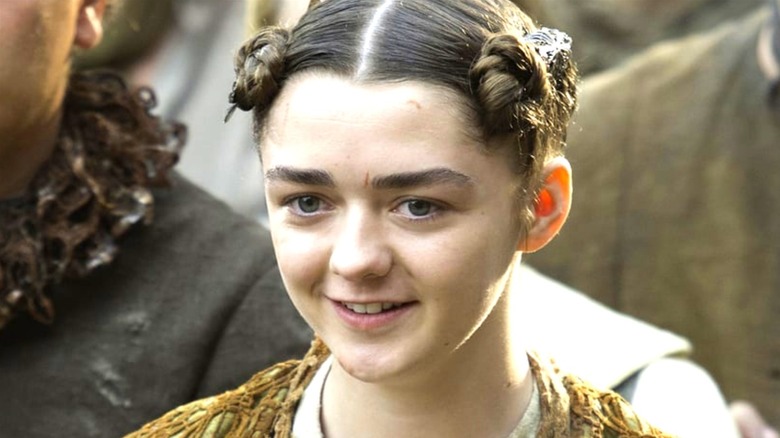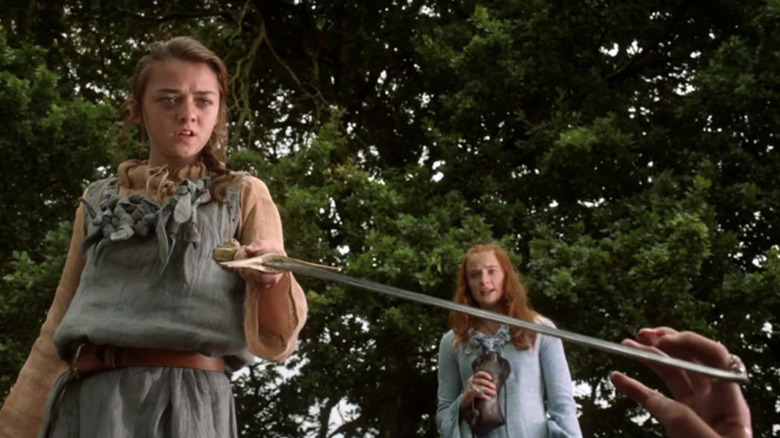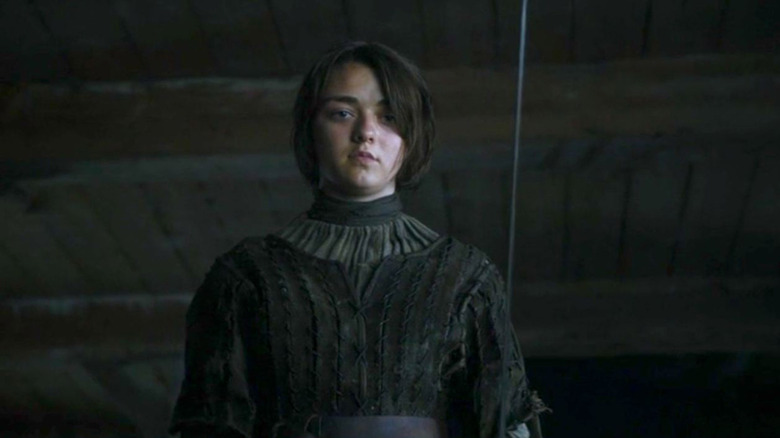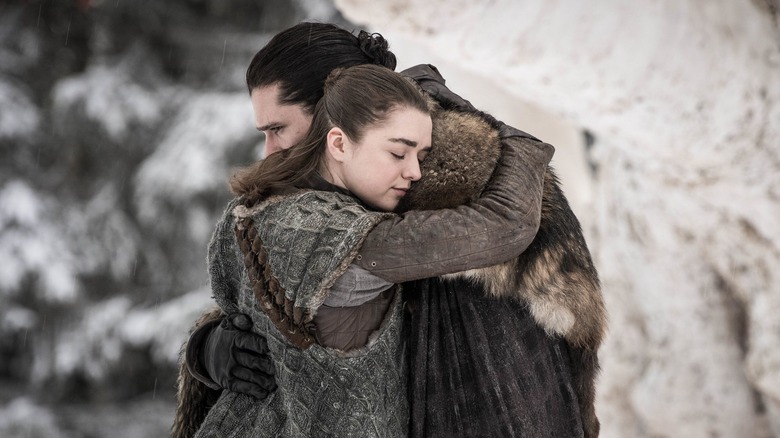What You Didn't Notice About Arya's Costumes In Game Of Thrones
"Game of Thrones" was known for its incredibly detailed world-building. People still take tours of the shooting locations across Europe, there was an entire team of costumers dedicated to distressing the clothes properly, and it only took eight seasons for them to build a Starbucks in Westeros.
All kidding aside, the world of "GoT" is richly detailed, and that's especially true of its costumes. Michele Clapton, costume designer for most of the show's run, told The Hollywood Reporter that she oversaw 70 to 100 people in the costuming department of "Game of Thrones." Every principal character costume was carefully thought out and labor-intensive. For example: Sansa's (Sophie Turner) wedding dress, for when she's supposed to marry Tyrion Lannister (Peter Dinklage), took 14 days to embroider.
We expect such details on a clothes-loving character like Sansa. One of her first defining characteristics is a desire to wear the silk dresses of the capital instead of the boring wool and fur of the North. But Arya Stark (Maisie Williams), a character defined by her indifference to all things girly, told her story through her clothing. Clapton and the costuming team hid Arya's backstory in the details of her costumes.
Arya wears her tomboy nature on her sleeves
When we first see Arya, she is annoyed at the girly task of embroidery. Already, she bristles under the gender expectations of Westeros. When Arya scuffles with child sociopath Joffrey (Jack Gleeson), she's modified her feminine dress to be more tomboyish and practical. The court dress is still technically on, but as Bustle notes, she's taken off the arms. She's also raised the hem with a belt (maybe borrowed from Mycah). The modified look is in stark contrast to Sansa, who has kept her sleeves on.
Westeros isn't medieval Europe, but it does make heavy reference to that time and place in real-world history. Walking around in mixed company un-sleeved would have been a major no-no in most locales of that time. It was effectively outlawed in the 1298 Consol of Narbonne – letting your chemise, the slip worn under the main dress, show too much was not ladylike and was therefore deemed illegal. Arya is essentially walking around with her bra straps hanging out.
Hiding in plain sight
When Arya escapes the Lannister guards, she's wearing a modified version of the Braavosi apron skirt her dancing/swordplay instructor wears. It is a gender-neutral garment in Braavos, again underscoring her disdain for femininity. Arya is already scruffy-looking, wearing her instructor's hand-me-downs, so it makes sense that she can blend in with the peasantry of King's Landing during her escape. Eventually, Yoren of the Night's Watch (Francis Magee) hides Arya among his recruits — giving Arya her most butch outfit yet.
Arya keeps this ability to camouflage throughout the rest of the show. Her main job is to hide in plain sight while training to become a Faceless Man at the House of the Black and White. Until Season 5, however, she keeps her House Stark undershirt. Eventually, she throws away all her former possessions, except Needle. It's also important to note that it's only while trying to become "no one" that she dresses in traditionally female attire.
Once a Stark, always a Stark
Arya eventually gives up the life of a Faceless Man, because she will always be Ayra Stark of Winterfell. When she does this, she starts wearing gray, the main color of House Stark. She wears a brown doublet and a blue-gray apron skirt, with pants underneath. The blue tinge of the gray subtly references her mother's family, House Tully, whose main color is blue.
In Season 8, Arya starts wearing her hair like her father, in a half-ponytail. Since winter is coming for real this season, she also layers up. She gets a fur-lined cloak, further underscoring her allegiance to the North.
All the women left alive by Season 8 get major shoulder pads. As Michele Clapton explained to Glamour, this was because the women wanted to assert power. "They have all had a journey, some harder than others," she said. "They've all been abused or disrespected by men, usually, simply because they are women. They all want power, some at any cost! Except maybe Arya, who wants freedom."



